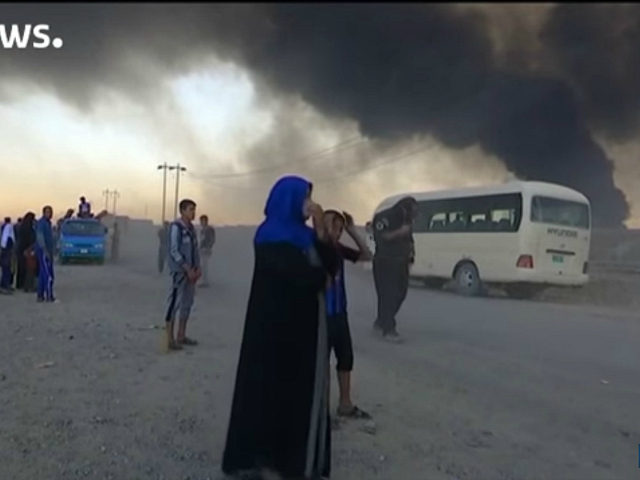Toxic fumes released by tons of waste at a chemical plant and sulphur mine near the Iraqi city of Mosul that were set on fire by the Islamic State (ISIS/ISIL) have reportedly killed at least two people and injured hundreds more.
ISIS sets fire to toxic chemical plant #Al-Mishraq near #Mosul, #Iraq, 2 civilians d https://t.co/uqkQm6bV0P #Mosul
— Peter Segers (@Peter_Segers_) October 22, 2016
Days after a U.S.-backed offensive to liberate Mosul from ISIS began on October 17, the jihadists torched at least part of the al-Mishraq chemical factory, which is located about 18 miles southeast of the city. The fire has reportedly been extinguished.
Massive bombardment by #Iraq‘s forces targeting #ISIS in the Mishraq chemical plant, south of #Mosul pic.twitter.com/LUwyzHC2zZ
— Syria Today (@todayinsyria) October 18, 2016
U.S. troops at Iraq base use protective masks over burning sulfur https://t.co/EilAScFYNb via @Reuters Mishraq chemical plant on fire
— Hamish DBG (@HamishDBG) October 22, 2016
Mosul is Iraq’s second-largest city and ISIS’s last urban stronghold in the country.
Prior to the start of the Mosul offensive, the Telegraph reported that thousands of tons of waste at the chemical production facility, considered one of the largest in the Middle East, had been rigged with explosives by ISIS.
Chemical plant torched by #ISIS/#Daesh militants leaves many injured from ‘toxic smoke’ #Mosul_Offensive #Iraq pic.twitter.com/i3GaZc0Rx6
— Islamic World Update (@islamicworldupd) October 22, 2016
The U.S.-led coalition against ISIS in Iraq and Syria had expressed concern that the jihadist group was planning to blow up the plant while defending Mosul from advancing U.S.-backed Iraqi forces and their allies, namely Kurdish troops, Sunni tribesmen, and Shiite militiamen, many backed by Iran. Their fears became reality.
The number of casualties from the large amounts of noxious gas released into the air by the burning plant varies. Some British news outlets claim that up to nine people have been killed and nearly 1,000 more wounded.
Meanwhile, Agence France-Presse (AFP), citing Iraqi General Qusay Hamid Kadhem, reports that two people have been killed and hundreds of others wounded.
The plant is located about six miles north of the Qayyarah airbase where several hundred U.S. troops are stationed alongside the Iraqi military. U.S. troops were forced to wear protective masks after the facility was set on fire.
“The toxic cloud, which includes deadly sulphur dioxide and hydrogen sulphide, combined with residue from burning oil wells, is a potentially fatal cocktail for those caught in the open or without gas masks,” notes the Telegraph.
“Sulphur dioxide gas is toxic when inhaled or when the skin or eyes are open,” adds Daily Mail. “It can lead to vomiting and stomach pain, while skin contact can cause stinging pains and, in severe cases, blindness.”
The burning chemical plant fueled a toxic pall that formed south of Mosul, underscoring ISIS’s ability to render Iraqi territory uninhabitable even as its self-proclaimed caliphate is under attack.
TIME reports:
Here in the Iraqi town of Qayyarah, in the desert south of Mosul, the sun is an orange orb burning through a screen of black and gray clouds that cover the sky. The sky at mid afternoon is the color of dusk, and the air is painful to breathe. Retreating ISIS fighters have set fire to oil wells as well as a sulfur plant in the area, sending up plumes of toxic black and white smoke that blanket the sky and burn the lungs. Some of the oil fires have burned since last summer.
“The al-Mishraq plant is our biggest chemical weapons concern,” Brig. Gen. Hajar Ismail, a Kurdish officer, told the Australian last week.
“The coalition is aware of it, as we have briefed them on the danger many times, and we believe it will be used by the Daesh against us as their equivalent of a chemical heavy weapon. If it isn’t captured very quickly it poses a danger to everything — to soldiers, civilians, animals and agriculture,” he added.
In anticipation of the Mosul offensive, U.S. officials conceded that coalition expected ISIS to use crudely-designed chemical weapons, primarily packed with a sulphur mustard gas agent, to defend their de-facto capital of Mosul in Iraq.
Last month, ISIS used chemical weapons against American troops at the Qayyarah airbase, but no one was killed or injured.

COMMENTS
Please let us know if you're having issues with commenting.